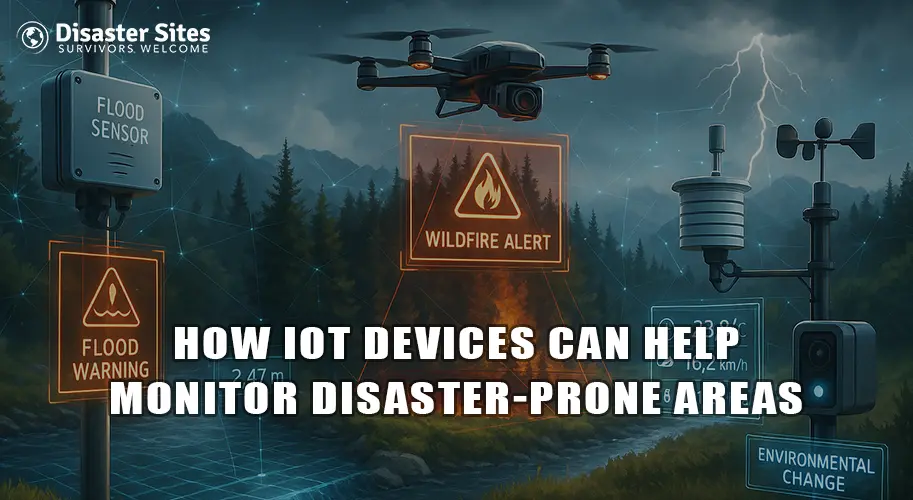We use cookies to personalise site content, social media features and to analyse our traffic. We also share information about your use of this site with our advertising and social media partners.
FEATURED
SPONSORED
VERIFIED

Fri at 12:20 AM -
7 minutes, 41 seconds
-120 Views 0 Comments 0 Likes 0 Reviews

Disasters like floods, earthquakes, wildfires, and so on happen all over the world and at an increasing frequency. They have been known to cause the most destruction of property, environments, and most importantly, human lives. After such incidents, timely detection and intervention have the ability to save lives and lessen disaster effects.
This is where IoT or the Internet of Things comes in. IoT is a system of interrelated things that monitor events and will communicate data with one another and User Interfaces in real time. IoT will use its sensors, smart devices, applications, and cloud based systems to monitor a specific environmental parameter, supply a warning of a possible threatening situation, and provide alerts to the affected communities.
In areas at risk of disasters, IoT can provide real time accommodation and preparation for not only local governing authorities, but also local residents. Local officials can use IoT to monitor changing circumstances from increasing water levels to tectonic activity. IoT devices are critical to disaster prevention and mitigation to ensure longer and healthier lives with less property damage.
The Internet of Things (IoT) is a system of devices in our daily lives that are connected to the Internet which allows them to send and receive data. In disaster management, IoT devices gather live data about environmental conditions and human risk.
As a starting point, sensors send readings of water levels, air quality, soil movement or temperature change. The reading is transmitted to the system's central intelligence which considers the readings for trends or threats to potential disaster. IoT creates monitoring solutions and offers instantaneous notices to the community or authorities. This level of data lets people respond faster than would eventually happen naturally - possibly saving lives and reducing destruction.
For more on how technology aids in disaster tracking, see Tracking and Managing Disasters With The Aid of Technology.
There are many different devices in the IoT category that monitor types of disasters. These devices will raise alerts based on specific risks, and whether there is a specific threshold exceeded. Some examples of devices are:
The working principles of IoT devices for the monitoring of disaster-prone areas consist of them providing real-time monitoring of these areas that may potentially face a natural disaster. By continuous data acquisition from a set of sensors, cameras, and weather stations, the system can give out warnings by detecting initial signs of hazards, such as rising water levels, unusual ground movement, or extreme weather changes.
Upon the identification of a threat of a disaster, there are immediate notifications that are sent out through an IoT system to local authorities, emergency responders, and residents to construct those evacuation measures, securing property, and applying other precautions.
Data from IoT devices also become useful for data-oriented decision making. This enables teams engaged in emergency response to effectively plan rescues, allocate resources to areas required most urgently, and respond swiftly to changes. When integrated with the neighbouring impact of any local disaster management system, the IoT helps to improve the frequency and accuracy of monitoring, improve response times, and therefore reduce the likelihood of harm and avoid loss of life entirely.
Earthquake early warning networks relate closely to Myanmar Earthquake 2025: Crisis Persists as Thousands Wait for Lifesaving Relief.
Many countries around the world are using IoT technologies to monitor disasters, and provide early warnings. The goal is to rapidly discover hazards and provide early warnings for responses that lead to saving lives.
Here are some examples:
IoT devices are transforming the way we monitor and respond to disasters. IoT devices are enabling faster access to real time data, early warnings, and predictive data which are enabling communities to prepare for and respond to natural hazards in a timely and effective manner. From detecting floods and earthquakes to monitoring wildfires and near real time landslides, IoT devices have made disaster management programs faster, more effective, and more accurate.

“To assist disaster survivors by providing a source for them to come together in time of need, to aid in the listing of events, information and other forms of assistance, and continuing support through the recovery process.”
Share this page with your family and friends.